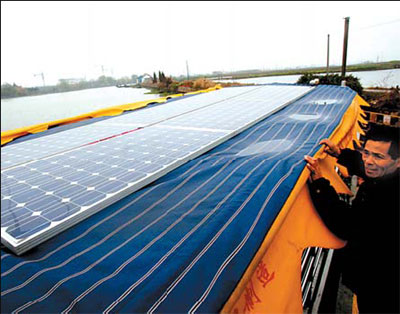| Diversification seems to be an odd word for Nan Cunhui, who has been focusing on producing electrical apparatus for over two decades.
But surprisingly Nan, the chairman and CEO of Chint Group Corp, launched a new venture one and a half years ago in Hangzhou, Zhejiang province, to produce solar cells. The new company, Chint Solar (Zhejiang) Co Ltd, specializes in research and development, manufacturing and distribution of photovoltaic products.
Nan says photovoltaic production in Hangzhou will become a strategic part of Chint's expedition toward high value-added businesses, along side its low-voltage electrical equipment in Wenzhou and high-voltage electrical apparatus manufacturing in Shanghai.

"The sales channels of solar cells almost coincide with that of low-voltage electrical apparatus. Some technologies could possibly be used to upgrade Chint's low-voltage electrical equipment," says Yang Liyou, Chint Solar's board member and general manager. Yang used to be head of the research department at BP Solar's thin film division.
As oil prices hit record high levels, Nan is confident about the market potential of solar energy. And while the sunshine in Hangzhou is not strong enough to realize Nan's complete solar energy ambitions, he is looking overseas to sunny Spain.
Chint plans to take stakes in a number of solar farms and in a factory making solar panels in Spain.
"We see Spain as the ideal base to develop our solar energy unit for the whole of the Mediterranean basin. Spain at the moment offers some of the best conditions in Europe for investment in alternative energy," Nan was quoted as saying by the Financial Times.
Chint is among companies from Germany, Austria, Israel and Japan that are piling into Spain's heavily subsidized renewable energy sector.
Chint Solar started producing crystalline solar cells in Hangzhou in May 2007. Chint invested 1 billion yuan last November to build the second-phase of the factory and to produce thin film solar cells, modules and systems. By 2010 the annual production capacity of the company is expected to reach 300 MW. The material costs of producing thin film solar cells are lower than that of crystalline solar cells. A worldwide shortage of silicon is pushing up the cost of crystalline silicon wafers that make up about 50 percent of a finished module.
China became the world's third largest producer of solar cells and modules in 2006, trailing Japan and Germany. But demand from the domestic market falls far behind that of the West and most Chinese solar cell companies have to rely on exports. China only accounts for about 10 percent of the sales of Suntech Power Holdings, the country's largest solar cell producer.
Worldwide shortage of silicon has pushed the price of solar-generated power up to 10 times the price of coal-fired electricity. Although the Chinese government issued a renewable energy law in 2006 to encourage development of renewable energies, there is no specific regulation on subsidies for the introduction of solar energy. |


